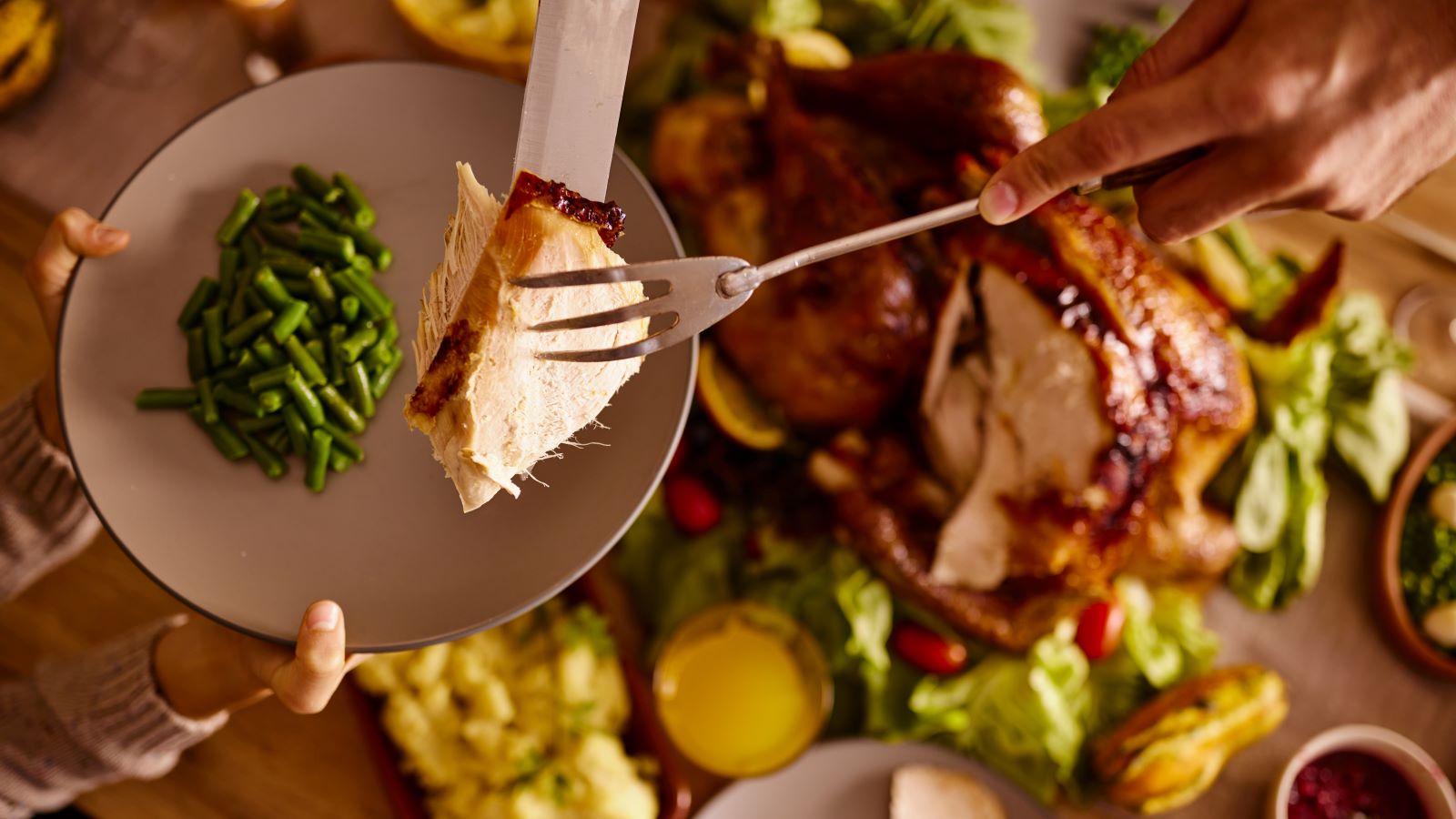<< Back
How to Build a Thanksgiving Plate Your Body Will Thank You For

November 06, 2025
There’s a lot to be grateful for on Thanksgiving — family, friends, and of course, the food. But between buttery casseroles and gravy boats that never seem to run dry, it’s easy to end the night in a food coma.
But according to Ulysses Wu, MD, with Hartford HealthCare, you don’t have to sacrifice your favorite dishes to enjoy your meal.
“Thanksgiving doesn’t have to be an all-or-nothing holiday,” says Dr. Wu. “It’s about enjoying the foods you love while making choices that support your health.”
With a little planning, you can build a healthy Thanksgiving plate that’s satisfying, colorful and full of flavor.
1. It starts with a good protein
Turkey isn’t just the star of the show – it’s the anchor your plate is looking for. Lean protein helps balance blood sugar and keeps you full long after dessert.
“Start by filling a quarter of your plate with turkey or another lean protein source,” says Dr. Wu. “It will keep you satisfied and helps curb the temptation to keep snacking.”
If you’re watching calories, skinless white meat is the best bet – and skip the fried or heavily buttered options. If you’re looking for something plant-based, consider lentil loaf or tofu as your main dish.
> Related: A Dietitian’s Guide to a Happy (and Healthy) Thanksgiving
2. Make room for colorful vegetables
Your plate deserves a little color – and not just from the cranberry sauce. Vegetables provide vitamins, antioxidants and fiber that help balance out heavier dishes.
“Try to fill at least half your plate with vegetables — roasted carrots, Brussels sprouts, green beans, squash,” says Dr. Wu. “It’s one of the easiest ways to add nutrition without feeling deprived.”
Roast them with olive oil, herbs and spices for flavor that rivals any casserole. Bright, fiber-rich vegetables not only make your meal more filling — they’re the foundation of a healthy Thanksgiving plate.
> Related: 5 Tips for Avoiding Heartburn on Thanksgiving
3. Choose your carbs wisely
Mashed potatoes, sweet potatoes, stuffing and rolls — oh my. It wouldn’t be Thanksgiving without them, but a few simple swaps can help you feel better later on.
“Opt for whole grains or complex carbohydrates like sweet potatoes, quinoa or brown rice,” says Dr. Wu. “They’re higher in fiber, which keeps you fuller and supports digestion. On Thanksgiving, I tend to avoid the heavily processed bread and rolls because I would rather save room for more flavorful foods.”
Can’t resist the traditional mashed potatoes? Try making them with a lighter touch — think olive oil instead of butter, or plant-based milk instead of cream.
4. Go easy on the extras
From gravy to creamy casseroles, sauces and sides make the holiday. But they can also sneak in more fat and sodium than you realize.
“Enjoy the extras in moderation,” says Dr. Wu. “A little gravy or butter is fine, but try to keep portions small and focus on flavor, not volume.”
Find turkey to be too dry? Try using homemade cranberry sauce instead.
“Rather than using a can, try making it from scratch. You can experiment with your own flavors, ranging from sweet to sour to savory. One of my favorites is a savory cranberry onion relish.”
A drizzle can go a long way, especially if you’ve already built a flavorful plate. Fresh herbs, citrus zest and roasted garlic can add richness without weighing you down.
> Related: 6 Healthy Foods to Add to Your Plate This Thanksgiving
5. Don’t skip dessert
It’s the grand finale – and it’s meant to be enjoyed.
“Choose your favorite and have a small portion,” says Dr. Wu. “You can always go back for seconds, but often a few bites are all it takes to satisfy that sweet tooth.”
Look for lighter options, like pumpkin pie or berries and low fat whipped cream. Pair with coffee or tea, and savor each bite.
> Related: Why You Always Crave Dessert After Dinner
Thanksgiving is meant to be enjoyed
Building a plate that supports your health doesn’t mean skipping the good stuff – it means choosing balance from the start.
“It can be easy to get carried away around the holidays,” says Dr. Wu. “And by itself, one meal isn’t too big of a problem – but from Halloween to New Year’s, it can quickly turn into a whole season of cheat days.”
Instead, aim to fill your plate with protein, fiber and color. That naturally leaves less room for the foods that make you feel sluggish.
“You’ll still enjoy everything you love, just in a way that leaves you feeling good afterward,” says Dr. Wu.
So go ahead — pile on the turkey, grab some veggies and enjoy that slice of pie. With balance and mindful choices, you’ll create a healthy Thanksgiving plate that leaves you feeling thankful — not overstuffed.